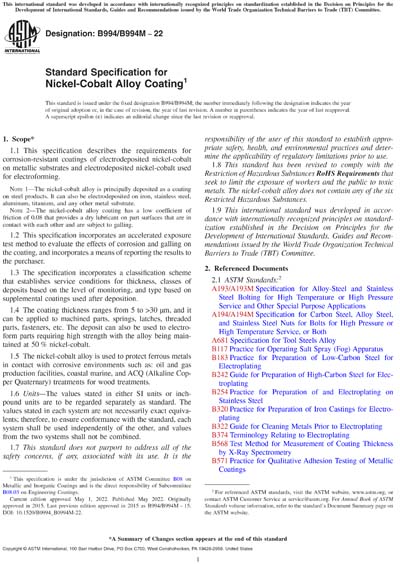Most recent
ASTM B994/B994M-22
Standard Specification for Nickel-Cobalt Alloy Coating
1.1This specification describes the requirements for corrosion-resistant coatings of electrodeposited nickel-cobalt on metallic substrates and electrodeposited nickel-cobalt used for electroforming.
Note 1:The nickel-cobalt alloy is principally deposited as a coating on steel products. It can also be electrodeposited on iron, stainless steel, aluminum, titanium, and any other metal substrate.
Note 2:The nickel-cobalt alloy coating has a low coefficient of friction of 0.08 that provides a dry lubricant on part surfaces that are in contact with each other and are subject to galling.
1.2This specification incorporates an accelerated exposure test method to evaluate the effects of corrosion and galling on the coating, and incorporates a means of reporting the results to the purchaser.
1.3The specification incorporates a classification scheme that establishes service conditions for thickness, classes of deposits based on the level of monitoring, and type based on supplemental coatings used after deposition.
1.4The coating thickness ranges from 5 to >30 μm, and it can be applied to machined parts, springs, latches, threaded parts, fasteners, etc. The deposit can also be used to electroform parts requiring high strength with the alloy being maintained at 50 % nickel-cobalt.
1.5The nickel-cobalt alloy is used to protect ferrous metals in contact with corrosive environments such as: oil and gas production facilities, coastal marine, and ACQ (Alkaline Copper Quaternary) treatments for wood treatments.
1.6Units - The values stated in either SI units or inch-pound units are to be regarded separately as standard. The values stated in each system are not necessarily exact equivalents; therefore, to ensure conformance with the standard, each system shall be used independently of the other, and values from the two systems shall not be combined.
1.7This standard does not purport to address all of the safety concerns, if any, associated with its use. It is the responsibility of the user of this standard to establish appropriate safety, health, and environmental practices and determine the applicability of regulatory limitations prior to use.
1.8This standard has been revised to comply with the Restriction of Hazardous Substances RoHS Requirements that seek to limit the exposure of workers and the public to toxic metals. The nickel-cobalt alloy does not contain any of the six Restricted Hazardous Substances.
1.9This international standard was developed in accordance with internationally recognized principles on standardization established in the Decision on Principles for the Development of International Standards, Guides and Recommendations issued by the World Trade Organization Technical Barriers to Trade (TBT) Committee.
Content Provider
ASTM International [astm]






